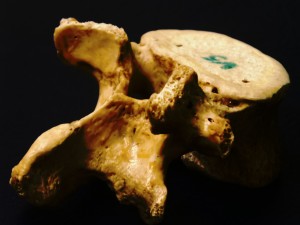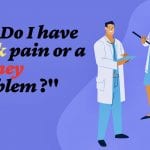


To better understand the cause of your back pain and your recommended treatment, it is helpful to appreciate some facts about spinal anatomy. The human spine has:
- 220 specialized ligaments
- More than 120 individual muscles
- Over 100 intricate joints
- 24 movable vertebrae
- 5 sacral and 3-5 coccygeal vertebrae
- 31 pairs of spinal nerves
- 23 intervertebral discs
- 3 major types of joints
- The cervical vertebrae are the most mobile of the 24 spinal vertebrae
- The 12 thoracic vertebrae articulate with 12 pair of ribs. The thoracic spine is designed for minimal movement
- The large stocky lumbar vertebrae are designed to support the weight of the body
- The sacrum and coccyx are composed of fused vertebrae and are also considered part of the spinal column
Facts About Back Pain
- Prevalence of back pain in Ontario is estimated at 64% of the adult population per year1
- Four out of five adults will experience low back pain sometime during their lifetime1
- After the common cold problems related to the low back are the most frequent cause of lost workdays in individual over 45 years of age2
- Back pain ranks second to headaches as the most frequent location for pain
- The estimated cost of back pain in Ontario is 2.4 billion dollars per year considering lost productivity, medical expenses and worker’s compensation benefits3
1Coyte PC, Asche CV, Croxford R, Chan B: The economic cost of musculoskeletal disorders in Canada. Arthritis Care & Research 1998, 11:315-25.
2Woolf AD, Pfleger B: Burden of major musculoskeletal conditions. Bulletin of the World Health Organization 2003, 81:646-656.
3Badley EM, Webster GK, Rasooly I: The impact of musculoskeletal disorders in the population: are they just aches and pains? Findings from the 1990 Ontario health survey. J Rheumatol 1995; 22: 733-739
Click Here to Download Patient Info Booklet – So Your Back Hurts
Basic Spinal Anatomy
Vertebrae
Your spine is made up of 24 vertebrae – like a cluster of blocks stacked on top of one another. The bony vertebrae provide structural support for the spine and protection for the spinal cord and nerve roots. Each vertebra is made up of a vertebral body in the front and facet joints in the back. The human spine is divided into three sections: 1) the cervical spine or neck is made up of 7 vertebrae, 2) the thoracic spine or upper back made up of 12 vertebrae and 3) the lumbar spine or low back which consists of 5 vertebrae.
Nerves
The spine has 31 pairs of spinal nerve roots, which branch off the spinal cord and exit through the inter-vertebral space between each vertebra. The nerve roots transmit sensory and motor impulses to and from parts of your body so that you can move and feel sensations.
The sciatic nerve is comprised of a bundle of nerves that run down the back of each leg to control movement and sensation. “Sciatica” occurs when a nerve is pinched from a herniated disc in the lower back or compressed by nearby musculature causing pain, or numbness and/or tingling down the back of the leg.
Facet Joints
Facet joints connect each vertebra to the vertebra above and below it. They are paired synovial joints and are located on the back of each vertebral body. Facet joints control the amount and direction of spinal movement and can be injured causing back pain by hyperextension, excessive twisting, lifting or straining. Facet joints are often a source of back pain.
Discs
The intervertebral discs are located between each vertebra allowing for bending, twisting and shock absorption. Between and padding each block (spinal vertebra) is a fibrous disc. The disc can be compared to a jelly doughnut – a jelly-like substance on the inside and tough tissue on the outside.
The outside of a disc is made up of a tough fibrous tissue called the annulus fibrosis and the inside of a disc is a soft gelatinous substance known as the nucleus pulposis. Lining the tops and bottoms of each vertebral body is a cartilaginous vertebral end plate. The discs allow for flexibility in your spine. They assist the muscles as shock absorbers, and provide cushioning between the vertebrae.
Common Spinal Injuries
Annular Tears
The annulus is the fibrous ring of the disc structure which surrounds the centrally located soft nucleus of the disc. The nucleus and annulus function together to create a pressurized structure that acts as a shock absorber. The annulus is a ligament and like any ligament in the body can be torn. Tearing of the annulus can produce pain because the annulus has pain fibers within its structure. Many episodes of low back pain are commonly tears in the annulus.
Bulging discs
Bulging discs are extremely common and generally does not cause back pain. Bulging typically occurs as with degeneration of the intervertebral disc. A bulging disc is formed when the nucleus (the spongy center of the disc), pushes against the fibrous annulus like a small bubble. Although the disc remains contained, if the bulge is large enough, pain may result from compression of nerve roots.
Cauda Equina Syndrome
Cauda equina syndrome is surgical emergency. This condition occurs when the nerve roots in the lower back are compressed, cutting off sensation and movement. Nerve roots that control the function of the bladder and bowel are especially vulnerable to damage.
Cauda equina syndrome may be caused by a herniated disc, tumor, infection, fracture, or narrowing of the spinal canal. It may also happen because of a violent impact, such as a car crash, a fall from significant height, or a penetrating injury, such as a gunshot or stabbing injury.
Symptoms of cauda equina include bladder and/or bowel incontinence, progressive strength loss in the lower extremities and altered sensation between the legs, over buttocks and inner thighs (saddle area parathesia.)
Degenerative Disc Disease
A common misconception is that degenerative disc disease (DDD) is a normal process of aging. Although disc degeneration is more common in people over the age of 50, degeneration is a slow process which manifests in the later years. Medical research has recognized factors which lead to degenerative changes over the long term. For example, those who smoke cigarettes and those who do heavy physical work (such as repeated heavy lifting) with abnormal or excessive spinal loading are prone to the development of degeneration of the disc. Likewise, people who are obese are also more likely to develop degenerative disc disease. A sudden (acute) injury leading to a herniated disc (such as a fall) or other spinal injuries may also begin the degeneration process. Muscle de-conditioning, lack of quality sleep, abnormal spinal curvatures, i.e. scoliosis and vascular changes in the vertebral end plates are other factors contributing to the condition.
The disc is made up of water, cells (chondrocytes), proteoglycan aggragates and collagen. The nucleus pulposis has a higher concentration of proteoglycans and absorbs the majority of the fluids received by the disc through the end plates. Alteration to the permeability of the end plate acts as a barrier to nutrient transport and is a major factor in the development of disc degeneration.
Deficiencies in fluid and nutrients result in changes in the composition and structure of the disc, particularly within the nucleus pulposis. As a consequence, as the nucleus becomes less gelatinous, its ability to absorb fluid and nutrients also diminishes. This leads to a cyclical process of nutrient and fluid loss leading to disc cell death (degeneration).
As the disc cells degenerate and the space between the vertebrae gets smaller, there is less padding between them, and the spine becomes less stable. The body reacts to this by constructing bony growths called bone spurs (osteophytes). Bone spurs can put pressure on the spinal nerve roots or spinal cord, resulting in pain and affecting nerve function. Disc deterioration also influences other spinal structures, such as facet joints, ligaments, and muscles, which can also become pain generators. Thus, disc degeneration may be responsible for the development of chronic low-back pain.
Disc Herniation
When the disc wall (annulus) becomes disrupted either from injury or as a consequence of degeneration, disc material from the nucleus pulposis can escape from its usual space between the vertebrae and enter the intervertebral foramen or the spinal canal. If a large amount of disc is herniated into the spinal canal, it can compress the spinal cord and cause buttock and leg pain and weakness (spinal stenosis). More commonly the disc material herniates into the intervertebral foramen causing inflammation of adjacent nerve roots. Radiating pain, numbness, tingling, and weakness may be present depending on the severity of the nerve compression. Back pain may or may not be present.
Facet Joint Pain

The motion segment is the basic building block of the spine. The motion segment consists of the disc in the front of the spine and the facet joints on either side in the back of the spine. If the disc is the floor of the spine, then the facet joints are corners of the roof. The facet joints are mechanical restraints on motion of the spine limiting forward slipping and placing a barrier to unrestrained twisting of the spine. The joints are similar to a knee joint in the sense that they have cartilage on opposing surfaces, a joint lining (synovium) and are enclosed in a capsule (fibrous container) and have lubricating joint fluid.
Post Operative Spinal Pain
Often following spine surgery, whether it is a fusion, discectomy or laminectomy patients can experience chronic pain in the spine and/or the arms or legs. This condition is commonly referred to as Failed Back Surgery from surgeons and the medical community. Fusion is a common aspect of all spinal surgeries. The true test of whether a back surgery was successful is to measure the reduction of pain. The success rate for spinal fusion surgery with single level fusions is 40-80%. With three levels or more, this drops to approximately 15%. Some of the most common causes of failed back surgery are residual foraminal stenosis , residual spinal stenosis , painful disc disease, or spinal instability due to removal of too much of the central disc or removal of too many supporting ligaments.
Osteoporosis
Osteoporosis is a bone disease characterized by deterioration of bone tissue and low bone mass. If left untreated, osteoporosis leads to increased bone fragility, fracture, disfigurement, loss of mobility and decreased independence.
Osteoporosis is often known as “the silent thief” because bone loss occurs without symptoms until a fracture occurs. One in four women over the age of 50 has osteoporosis and at least one in eight men over 50 also has the disease. Eighty percent of hip fractures are osteoporosis-related which result in death in up to 20 percent of cases, and disability in 50 percent of those who survive.
Sacroiliac Joint Sprain/Strain
The sacroiliac joints are located at either side of the sacrum. These joints can often get jammed or in some cases one half of the sacral spine can glide forwards or backwards, which is often referred to as a twisted pelvis. When this occurs it often irritates the Iliolumbar ligament and capsule surrounding the joint which results in inflammation and pain. Sprain/strain of the sacroiliac joints and associated ligaments are extremely common. Symptoms of the condition include pain located either to the left or right of your lower back. The pain can range from an ache to a sharp pain which can restrict movement. The pain may radiate out into your buttocks and will often radiate to the front into the groin or referred into the lower limb which can be mistaken for sciatica. Classic symptoms are difficulty turning over in bed, struggling to put on shoes and pain and stiffness in the lower back when getting up after sitting for long periods.
Sciatica
Sciatica is defined as pain beginning in the back, radiating into the buttock and into the leg (often ending at the knee.). Sciatica can be caused by a disc herniation or more often from a condition known as “piriformis syndrome” which can cause pain through compression or irritation of the sciatic nerve as it passes through the piriformis muscle.
Spinal Stenosis
Spinal Stenosis is the narrowing of the spinal canal caused by bone spurring, ligament rigidity or disc herniations and less commonly by spinal tumors, Paget’s disease and spinal dislocation/instability. Any narrowing of the canal puts pressure on the spinal nerves and/or spinal cord. Unless the individual is born with a small spinal canal (congenital stenosis), spinal narrowing occurs most commonly from progressive degenerative changes. If the narrowing in the spinal canal puts pressure on the spinal nerves or cord, then the patient may complain of pain, numbness, or weakness in the leg(s) The spinal canal is narrowest when standing and walking and is larger when sitting. So most patients with lumbar spinal stenosis will complain of leg symptoms while walking or standing and are relieved while sitting. Some patients bend over as they walk because they have learned that their leg or legs hurt less in that position. Bending forward (flexion) makes the spinal canal larger and may relieve pressure on the spinal nerves and reduce the symptoms. Spinal stenosis can be very challenging to diagnose and manage due to its multi-factorial nature, especially in the senior population.
Spondylolisthesis
Spondylolisthesis is the slipping of one vertebra forward or backward over another and is graded based on the degree of slippage. This can be caused by a birth defect, pathology, a fracture or from degenerative disc disease. A significant spondylolisthesis can lead to serious spinal instability and/or compression of the spinal cord resulting in neurological deficits.
Whiplash Injury
Whiplash describes an injury to the brain, cervical vertebrae and the adjacent soft tissues. It is produced by a sudden jerking or acceleration and deceleration of the head with respect to the cervical spine. This injury is typical in a motor vehicle accident especially in rear end collisions.
There are a broad spectrum of injuries and symptoms associated with whiplash injuries. In most cases, soft tissues, mainly muscles and ligaments, cause pain because they have been stretched beyond their normal limits (sprain/strain). Violent whiplash can compress the discs of the cervical spine so hard that they tear and herniated and cause nerve root irritation. In serious injuries, there may be damage to blood vessels, nerves or dislocation/ fractures of the spinal vertebrae.
One may not feel significant discomfort until several days after the accident. The pain may gradually intensify, moving to the back of the head, chest muscles and one or both shoulders and upper arms. The person may complain of hoarseness and have difficulty in swallowing. The neck typically feels tender, stiff and swollen and hurts when the head is rotated or flexed from side to side.
There are sometimes complaints of blurred vision, ringing in the ears, dizziness and cognitive impairments associated with some whiplash injuries. This may be the result of impaired proprioceptors in the cervical spine as well as mild damage to the brain from the acceleration/deceleration impact.







